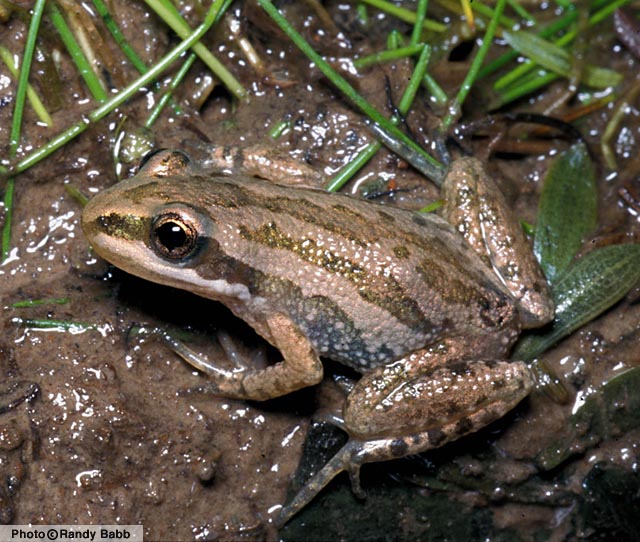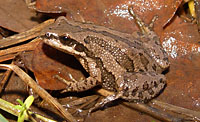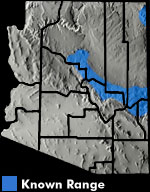Online Field Guide to The Reptiles and Amphibians of Arizona



Coconino County, AZ
 Coconino Co., AZ |
| WESTERN CHORUS FROG Pseudacris triseriata | |
|
DESCRIPTION: The Western Chorus Frog is a relatively small (to about 1.5 inches) frog with neither conspicuous toe pads nor significant webbing between the toes. This frog has a highly variable color pattern. It is light tan, gray, or brown on the back, sometimes with a greenish wash, but most have three dark stripes down the back that may be broken or replaced by lines of spots. The dark stripes or spots are absent in some individuals. There is also a lateral dark stripe that runs from the nostril through the eye to the groin area. A white line is present below that stripe on the upper lip of the frog. In cold temperatures colors of the frog darken. Males have a dark throat patch during the breeding season. Larger tadpoles are dark above and silvery below. Eyes are not positioned high on the head. They grow to about 1.5 inches prior to metamorphosis. DISTRIBUTION: The Western Chorus Frog is a high mountain species of the Mogollon Rim, the White Mountains, and east into New Mexico. Disjunct populations occur in extreme northeastern Arizona in the Chuska Mountains. HABITAT: This species is typically found on the ground or in low shrubs or grass at or near breeding ponds, which include often shallow and temporary ponds, cattle tanks, lake margins, wet meadows, and roadside ditches. Sites without fish are preferred for breeding. The species sometimes breeds in permanent water. This frog is rarely encountered outside of the breeding season. BEHAVIOR: Migrations of adults from overwintering sites to breeding locations, and of metamorphs from breeding sites to nearby uplands have been documented, but not in Arizona. The location and habitats of this frog outside of the breeding season are unknown in Arizona. REPRODUCTION AND CALLS: Breeding begins in the spring, often when ice and snow are still present. Probably breeds primarily from March to early June in Arizona. The male has a surprisingly loud call that sounds like “pprreeep” or someone running a finger down the teeth of a comb. During peak breeding periods, males call during the day as well as at night. Each female lays up to 1,500 eggs, which are deposited in small packets of 20-100, and are attached to submerged sticks, leaves, or grass. Tadpoles hatch in a few days to a week or more, and metamorphosis occurs in 6-13 weeks. DIET: The Western Chorus Frog feeds upon a number of small invertebrates, such as flies, springtails, spiders, snails, and ants. REMARKS: This frog was recently recognized as a species separate from the boreal chorus frog (Pseudacris maculata); however, P. triseriata is a complex of diverse taxa that extends across 2/3rds of the United States. Further taxonomic work is needed to clarify taxonomic associations. Declines of this “species” have been noted in the northeastern U.S. and adjacent portions of Canada. By Jim Rorabaugh Bezy, K.B., R.L. Bezy, K. Bolles, and E.F. Enderson. 2004. Breeding behavior of the Western chorus frog (Pseudacris triseriata complex) in Arizona. Do chorus frogs call in the snow on the Colorado Plateau? Sonoran Herpetologist 17(8):82-85 Brennan, T.C., and A.T. Holycross. 2006. A Field Guide to Amphibians and Reptiles in Arizona. Arizona Game and Fish Department. Phoenix, AZ. Degenhardt, W.G., C.W. Painter, and A.H. Price. 1996. Amphibians and Reptiles of New Mexico. University of New Mexico Press, Albuquerque, NM. Moriarty, E., and M.J. Lannoo. 2005. Pseudacris triseriata (Weid-Neuwied, 1838) Western chorus frog. Pages 485-488 in M.J. Lannoo (ed), Amphibian Declines: The Conservation Status of United States Species. University of California Press, Berkeley, CA. |
|
Visit Partners in Amphibian and Reptile Conservation:


HOME
Copyright © 2023, Arizona Game and Fish Department. All rights reserved.
If you make use of the textual contents of this site in reports, publications, etc. please cite and credit the author(s) and photographer(s). All photos on this website are copyrighted. However, those found in the species account section may be used for any noncommercial scientific, educational, or conservation purposes provided that photographs are not altered and continue to bear the copyright symbol and name of the photographer. Please contact the photographer regarding commercial use of copyrighted photographs.










